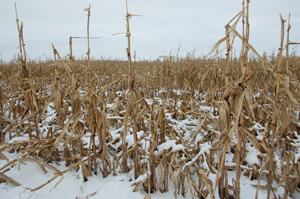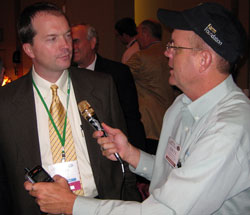Who would have thought we would still be doing BASF Headline Harvest reports the last week of the year?
 This week we traveled to northern Illinois where there is still lots of corn in the fields and lots of flooded areas due to the extremely wet fall. I talked with Ron Hansen of Kankakee, who still has about 300 acres to combine, but he says it is still standing pretty well, despite a storm that blew through last week with 40 mph winds. It helped him see a side by side comparison of how Headline helped with standability in this late year. “We had a check on one field and that check was 100 percent down from end to end, and where the Headline was there were spots it was down but it was not down at the root, where as with the check it was,” Ron told me.
This week we traveled to northern Illinois where there is still lots of corn in the fields and lots of flooded areas due to the extremely wet fall. I talked with Ron Hansen of Kankakee, who still has about 300 acres to combine, but he says it is still standing pretty well, despite a storm that blew through last week with 40 mph winds. It helped him see a side by side comparison of how Headline helped with standability in this late year. “We had a check on one field and that check was 100 percent down from end to end, and where the Headline was there were spots it was down but it was not down at the root, where as with the check it was,” Ron told me.
Ron says the weather this year has just been “nuts.” “With the cool summer, it’s done some things that I’ve never seen in my lifetime, like not maturing the corn and beans like normal so we are caught with this real late wet corn – but we are having good yields.”
As to when he will get the rest of his crop out of the field, Ron said he just doesn’t know. “I’ve harvested at Christmas, I’ve never harvested at New Year’s,” he said.
Watch the video interview and listen to or download the audio of my interview with Ron below.

 The
The  These photos are two different fields I saw along the road between Cullom and St. Anne that showed a pretty stark contrast in standability. No idea of who the farmers are who own those fields, what varieties they planted or plant health products they used, but I’d say the farmer with the field in the left photo has a better chance of salvaging a decent crop, whenever that may be.
These photos are two different fields I saw along the road between Cullom and St. Anne that showed a pretty stark contrast in standability. No idea of who the farmers are who own those fields, what varieties they planted or plant health products they used, but I’d say the farmer with the field in the left photo has a better chance of salvaging a decent crop, whenever that may be.  To tell us what’s new with John Deere I spoke to Matthew Arnold, Sr. Marketing Representative. Matthew was attending the NAFB Trade Talk to discuss the
To tell us what’s new with John Deere I spoke to Matthew Arnold, Sr. Marketing Representative. Matthew was attending the NAFB Trade Talk to discuss the  I’m going to be talking about social media and networking at the upcoming Chicago Farmers Farmland Investment Fair. But before getting there I talked about it with Rich Schell,
I’m going to be talking about social media and networking at the upcoming Chicago Farmers Farmland Investment Fair. But before getting there I talked about it with Rich Schell,  We had a great holiday week
We had a great holiday week  What’s new with Alltech? That’s a good question and one I posed to Billy Frey at the NAFB
What’s new with Alltech? That’s a good question and one I posed to Billy Frey at the NAFB  The National Association of Farm Broadcasting recently released its latest Internet Usage Study. Cindy spoke with Ted Haller
The National Association of Farm Broadcasting recently released its latest Internet Usage Study. Cindy spoke with Ted Haller  The survey explores producer activity and preferences in accessing the Internet for agricultural business information, as well as use of texting and social media. Specific to broadcaster interests, it also probes interest in e-newsletters and the preferred content of agribusiness-focused Web sites.
The survey explores producer activity and preferences in accessing the Internet for agricultural business information, as well as use of texting and social media. Specific to broadcaster interests, it also probes interest in e-newsletters and the preferred content of agribusiness-focused Web sites. 